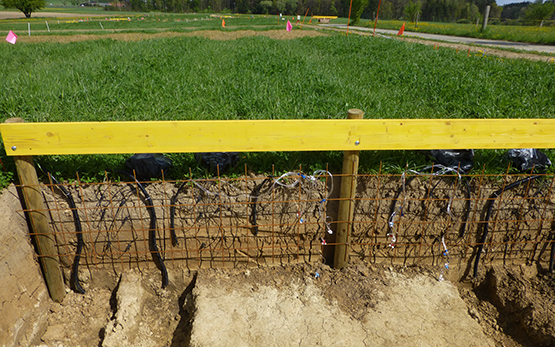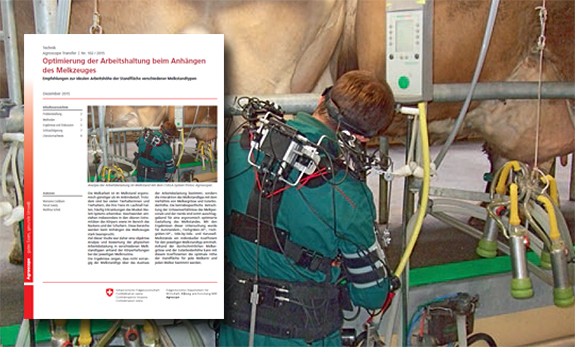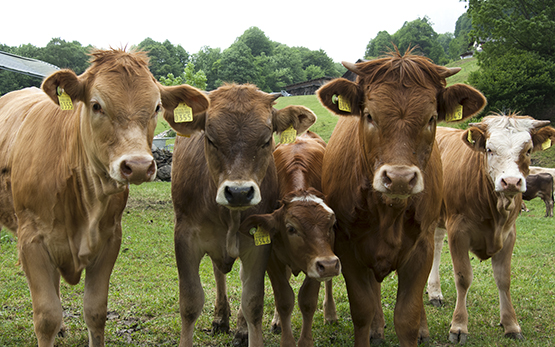Latsch A. J.
Smart-N: Resultate und Erkenntnisse aus 2 Jahren On-Farm-Versuchen.
Dans: Beitrag der ortsspezifischen N-Düngung zum Absenkpfad. 15. Januar, Tänikon. 2024, 1-12.
Latsch A. J.
Projet de ressources PFLOPF : Économiser des produits phytosanitaires par les technologies numériques.
Dans: Journée phytosanitaire Grandes Cultures. 12 janvier, Bienne. 2024, 1-13.
autres langues: allemand
Latsch A. J., Kramer B.
Fumure par modulation intra-parcellaire : est-ce viable ?
Revue UFA, 12, 2023, 14-15.
autres langues: allemand
Latsch A. J.
Smart-N: Ortsspezifische Düngung zur Reduktion der Stickstoff-Überschüsse in der Praxis.
Dans: BDU-Herbsttagung. 15. November, Ed. Agridea, Olten. 2023, 1-15.
Latsch A. J.
Ressourcenprojekt PFLOPF: Pflanzenschutzoptimierung mit Precision Farming.
Dans: 5. News Spot Agridigital. 9. November, Ed. Chartagemeinschaft Digitalisierung, 2023, 1-12.
Latsch A. J., Anken T.
Standortangepasste N-Düngung zur Reduktion der Überschüsse: Smart-N und weitere AGS-Projekte.
Dans: Projektplattform. 31. Oktober, Tänikon. 2023, 1-16.
Anken T., Latsch A. J.
Characteristics of a spot sprayer for the treatment of Rumex obtusifolius in meadows.
Landtechnik, 78, (3), 2023, 139-151.
Latsch A. J.
Effizienter Pflanzenschutz durch moderne Technik.
E-Agil, 2, 2023, 3.
Gasser L., Perez F. C. , Cockburn M.
Can meteorological data improve the short-term prediction of individual milk yield in dairy cows?
Journal of Dairy Science, In Press, 2023.
Anken T., Latsch A. J.
Schafft Spot Spraying nach dem Durchbruch auf Wiesen den Sprung in die BFF?
Dans: Pflanzenschutztagung. 13. Januar, Ed. Plattform Ackerbau, Biel. 2023.
Anken T., Kramer H., Kole J.
Sprayertest for Spot Sprayers.
Dans: SPISE - Conference. 3. May, Ed. SPISE, Den Haag. 2023, 1-21.
Anken T.
Spray drones in Switzerland.
Dans: DJI Agriculture Europe Distributor's Meeting. 1. June, Ed. DJI Europe, Budapest. 2023, 1-18.
Anken T., Rombach M., Mettler D.
Digitalisierung in der Landwirtschaft.
Dans: Klima und Wandel im Gebirge: Der etwas andere Schlussbericht. Ed. Stiftung Lebensraum Gebirge, 2022, 20.
Simmler M., Meyer P., Liebisch F.
Bodeninformation aus Radioaktivität.
UFA-Revue, 9, 2022, 20-22.
Argento F., Liebisch F., Anken T., Walter A., El Benni N.
Investigating two solutions to balance revenues and N surplus in Swiss winter wheat.
Agricultural Systems, 201, 2022, 1-10.
Argento F., Liebisch F., Simmler M., Ringger C., Hatt M., Walter A., Anken T.
Linking soil N dynamics and plant N uptake by means of sensor support.
European Journal of Agronomy, 134, 2022, 126462-126472.
Anken T.
Digitale Technologien für eine effiziente und nachhaltige Landwirtschaft.
Dans: Technology Outlook 2021. Ed. SATW, 2022, 94-94.
Anken T.
Ecorobotix international ausgezeichnet.
Agroluchs, 1, 2022, 16-18.
Keck M.
Geruch aus der Tierhaltung - von der Quelle zur Immission?
Dans: Fachtagung Emissionsbeurteilung in der Nutztierhaltung 2022. 05. April, Ed. HBLFA Raumberg-Gumpenstein, Raumberg-Gumpenstein. 2022, 1-30.
Anken T.
La téléphonie mobile, un outil vital pour l’agriculture.
Revue UFA, 4, 2022, 62-64.
autres langues: allemand
Latsch A. J.
PFLOPF - Pflanzenschutzoptimierung mit Precision Farming.
Dans: Projektplattform. 19. April, Tänikon - Agroscope. 2022, 1-17.
Anken T., Abt F., Binder S.
La digitalisation au service d’une fumure azotée plus efficiente.
Revue UFA, 3, 2022, 50-51.
autres langues: allemand
Latsch A. J.
PFLOPF Wirkungsmonitoring: Resultate und Ausblick.
Dans: PFLOPF Teilnehmerworkshop Sonderkulturen. 16. März, Online-Workshop. 2022, 1-18.
Latsch A. J.
PFLOPF Wirkungsmonitoring: Resultate und Ausblick.
Dans: PFLOPF-Teilnehmerworkshop Ackerbau. 09. März, Online-Veranstaltung Ressourcenprojekt PFLOPF. 2022.
Gandorfer M., Hoffmann C., El Benni N., Cockburn M., Anken T., Floto H.
Informatik in der Land-, Forst- und Ernährungswirtschaft: Fokus: Künstliche Intelligenz in der Agrar- und Ernährungswirtschaft.
Dans: 42. GIL Jahrestagung. P-317, Ed. Gesellschaft für Informatik e.V. (GI), Agroscope, Tänikon, Ettenhausen, Schweiz. 2022.
Hart L., Dickhoefer U., Paulenz E., Umstaetter C.
Evaluation of a binary classification approach to detect herbage scarcity based on behavioral responses of grazing dairy cows.
Sensors, 22, 2022, 968-995.
Keck M., Keller M., Schrade S.
Odour concentration of various emitting area sources from cattle farms.
Dans: IWA2021 Conference. 26-27 October, Ed. Olores, Bilbao (ES). 2021, 1-6.








